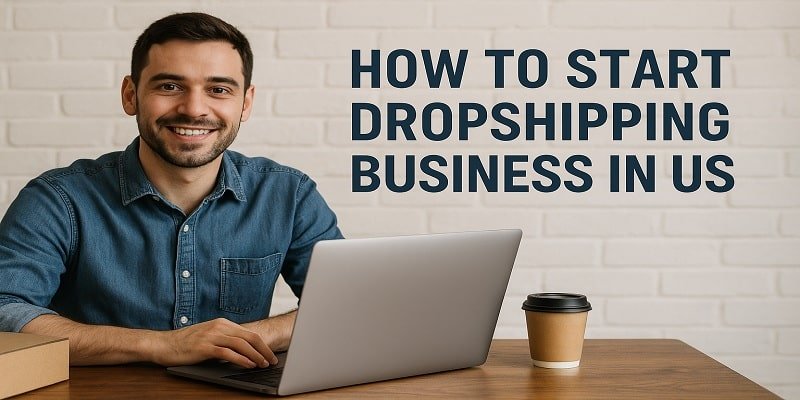“How to Start Dropshipping Business in US”
How to Start Dropshipping Business in US: Starting a dropshipping business is one of the easiest ways to get into e-commerce with low start-up costs. Unlike traditional retail, you don’t have to stock inventory or manage shipping—your supplier does that for you. Although dropshipping is easy to start, it takes strategy to make it profitable.
In this guide, we’ll offer 10 essential tips to help you build a successful dropshipping business in the US. Whether you’re a beginner or looking to expand, these insights will set you up for long-term success.
1. Choose the right region
Your region determines your success. Instead of selling everything, focus on a specific market with high demand but low competition. Use tools like:
- Google Trends (trends.google.com) to see what’s popular.
- Amazon Best Sellers (amazon.com/bestsellers) to find trending products.
A profitable dropshipping business often targets the following areas:
- Eco-friendly products
- Pet supplies
- Fitness equipment
- Home organization
Avoid oversaturated markets (e.g., cheap phone accessories) unless you have a specific vision.
2. Find a reliable supplier
Your supplier affects product quality, shipping times, and customer satisfaction. The best platforms to find dropshipping suppliers in the US are:
- AliExpress (aliexpress.com) – Best for beginners.
- SaleHoo (salehoo.com) – Verified suppliers with fast shipping.
- US-based suppliers (e.g., Spocket – spocket.co) – Fast delivery times.
Key checks before choosing a supplier:
✔ Read reviews
✔ Test order samples
✔ Check shipping times (aim for less than 2 weeks)
3. Build a professional online store
Your store is the face of your brand. Use Shopify (shopify.com) or WooCommerce (woocommerce.com) for easy setup.
Store essentials:
✅ Clean, mobile-friendly design
✅ High-quality product images
✅ Clear return and shipping policies
✅ Trust badges (SSL, secure checkout)
Pro tip: Use a .com domain (from Namecheap – namecheap.com) for credibility.
4. Price products strategically
Many new dropshipping business owners underprice products, which reduces profits. Follow this formula:
Product price = supplier costs + marketing + overhead + profit (30-50%)
Example:
- Supplier costs: $10
- Selling price: $25-$30 (after ads and fees)
Use a tool like Jungle Scout (junglescout.com) to analyze competitors’ prices.
5. Optimize for SEO and organic traffic
Paid ads work, but SEO brings free and long-lasting traffic. Optimize your store by:
- Using keywords in product titles/descriptions (e.g., “best eco-friendly water bottles”).
- Writing blog posts (e.g., “top 10 yoga mats for working out at home”).
- Getting backlinks from guest posts or influencers.
Tools like Ubersuggest (ubersuggest.com) help find low-competitive keywords.
6. Run smart Facebook and Google ads
Paid ads drive sales faster. Start with:
- Facebook/Instagram ads – great for visual products.
- Google Shopping ads – best for high-intent buyers.
Tips for better ROI:
✔ Target lookalike audiences (people similar to past buyers).
✔ Use video ads (2-3x higher engagement).
✔ Test small budgets ($5-$10/day) before scaling.
For ad strategies, check out Facebook Blueprint (facebook.com/business/learn).
7. Provide excellent customer service
Happy customers = repeat buyers and referrals. Improve support:
- By using live chat (via Tidio – tidio.com).
- By responding within 24 hours.
- Handle refunds politely (even if the supplier is at fault).
Bad reviews kill dropshipping businesses, so make customer experience a priority.
8. Test and scale successful products
Not all products sell well. Use the “10-product test” method:
1. Create a list of 10 trending products.
2. Run low-budget ads ($5/day per product).
3. Scale the 2-3 best-performing products.
Winners often have:
🔥 High demand (see TikTok trends).
🔥 Good profit margins ($15+ per sale).
🔥 Low competition (not sold by big brands).
9. Automate your business
Manual work slows down growth. Automate with:
- Oberlo (oberlo.com) – Import products automatically.
- Zapier (zapier.com) – Connect apps (e.g., order confirmations).
- ShipBob (shipbob.com) – Faster US fulfillment.
Automation lets you focus on marketing and scaling.
10. Continuously analyze and improve
Track key metrics using Google Analytics (analytics.google.com) and Shopify reports:
- Conversion rate (aim for 2-3%+).
- Average order value (increases with bundles).
- Customer lifetime value (increases with email marketing).
Adjust strategies monthly—what worked last year may not work now.
Final Thoughts: How to Start Dropshipping Business
A dropshipping business can be profitable if done right. Focus on product research, customer trust, and smart marketing to help you stand out. Start small, learn fast, and scale what works.
For more information, visit Shopify’s blog (shopify.com/blog) or Oberlo’s resources (oberlo.com/blog)
FAQs on How to Start Dropshipping Business
1. Is dropshipping legal in the US?
Yes! Dropshipping is completely legal, provided you follow business laws (taxes, refund policies, and supplier agreements).
2. How much money do I need to get started?
You can start with $100-$500 (for domain, hosting, and ads). Unlike traditional stores, you don’t need inventory upfront.
3. Which platform is best for dropshipping?
Shopify (easiest for beginners) or WooCommerce (cheaper but requires WordPress skills).
4. How long does shipping take?
From 2 days (US suppliers) to 3-4 weeks (AliExpress). Faster shipping = happier customers!
5. Can I run a part-time dropshipping business?
Absolutely! Many entrepreneurs start part-time and grow it later. Automation tools help manage orders easily.
Have more questions? Ask below! 👇
More Like This-


